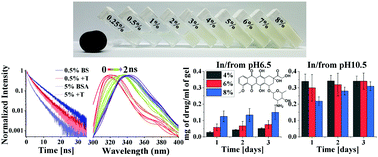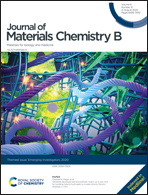Exploring the inner environment of protein hydrogels with fluorescence spectroscopy towards understanding their drug delivery capabilities†
Abstract
Hydrogels are common platforms for drug delivery applications. Amongst the different loading and release methodologies, physisorption loading and passive release stand out for their straightforwardness. However, evaluating the inner environment and the surface of the polymer can be complicated, as they can be very different from the properties of the monomer composing the hydrogel. Here, we explore the inner environment of macroscopic bovine serum albumin (BSA) hydrogels, by using both the native Trp residues of the protein and the pyranine photoacid as fluorescent probes. Time-resolved fluorescence is used to follow the fast solvation dynamics of Trp and the excited-state proton dissociation of pyranine. The results show that upon gelation, the surface of the BSA within the hydrogel is less accessible to water, i.e., more hydrophobic, as compared to before gelation. This understanding is used to rationalize the different drug binding efficiencies of the anti-cancer drug doxorubicin to the hydrogel at different pH values, which changes the charge of the molecule. Finally, we give proof for the hydrogels capacity to effectively function as drug-carrier systems in vitro, using different cancer cell lines over a 7 day period. Our study shows that relatively simple spectroscopic measurements can result in a fundamental structural and chemical understanding of (protein) hydrogels. From an application point of view, our protein hydrogels are very easy to form, without any need of complex chemical modification, they are very low cost as compared to other hydrogels, and show slow and sustained drug release profiles, all very sought-after properties.

- This article is part of the themed collection: Journal of Materials Chemistry B Emerging Investigators


 Please wait while we load your content...
Please wait while we load your content...